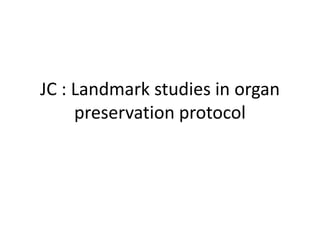
Landmark studies in organ preservation protocol
- 1. JC : Landmark studies in organ preservation protocol
- 2. Introduction - Treatment considerations in H& N cancers – • Highest loco- regional control • Anatomical with functional preservation • Stage I / II Single modality ( Surgery or RT ) • Stage III / IV Combined modality Surgery + RT (in most patients)- used to be the treatment modality Chemotherapy + RT – organ preservation protocol
- 3. • When different modalities available, one with maximum chance of cure should be used • When different modalities have same results, one offering better quality of life, with organ, function preservation and good cosmetic results should be used
- 4. Functional larynx – • Respiration • Phonation • Swallowing • Protection of lower airway • Patient is able to eat and speak without a permanent tracheostomy at a point when no recurrence is expected ( > 2yrs after treatment )
- 5. Post laryngectomy – • diminished sense of smell and therefore taste • difficulty in swallowing, related to changes in the pharyngeal anatomy • emotional and cosmetic effects of both losing an organ • living with a permanent tracheostoma • Voice Quality
- 7. Prospective, randomized study Previously untreated advanced (Stage III or IV) laryngeal squamous carcinoma Compare the results of induction chemotherapy followed by definitive radiation therapy with conventional laryngectomy and postoperative radiation
- 8. Methods – Exclusion - Patients with T1N1 carcinomas, unresectable cancers, distant metastases, previous radiation therapy
- 9. Treatment regimen – Chemotherapy • Induction chemotherapy - Cisplatin 100mg/m2 rapid IV followed by 5FU 1000mg/m2/day for five days - Chemo repeated on days 22 and 43 - Assessed 18 to 21 days after second cycle of chemo – clinical and IDL
- 10. • Complete response – complete disappearance of clinically evident tumour • Partial response – At least 50% reduction in sum of product of longest dimension and its perpendicular for each tumour – Patients with atleast a partial response and no progression of neck disease received 3rd cycle of chemo, followed by RT – Any lesser – surgery and post op RT
- 11. Radiation – Definitive radiation therapy - 66 to 76 Gy to the primary tumor site.
- 12. Surgery – - Wide-field total laryngectomy - Horizontal partial laryngectomy.
- 13. Conclusion – Estimated 2 yr survival – 68 % Laryngeal preservation – 64 %
- 14. • Reanalysed in 1998 – for voice and swallowing outcomes • Voice preservation better with chemoRT • Swallowing problems similar even after 2 years
- 15. EORTC • Prospective, randomized • European Organization for Research and Treatment of Cancer (EORTC) in 1990 • Compare a larynx-preserving treatment (induction chemotherapy + definitive RT with conventional treatment in previously untreated and operable patients with histologically proven squamous cell carcinomas of the pyriform sinus or aryepiglottic fold
- 17. EORTC 24954 • Comparing 2 different CT regimens – • Sequential arm – 2 cycles as in previous trial – responders received two more cycles and RT • Alternate arm – Cisplatin and 5fu CT on weeks 1,4,7,10; RT in the other weeks • Hence – lesser overall dose of chemo with lesser S/E • Similar survival and laryngeal preservation in both arms, lesser complications in alternate arm due to dose difference
- 19. GORTEC trial 2000-01 • Cisplatin, 5FU and Docetaxel • 2 arms – TPF and PF • End point – overall survival and disease free survival • No significant difference in 5 or 10 year survivals • 3 yr larynygeal preservation was ~70% in TPF
- 20. • Data on quality of life seem to favor chemoradiation for organ preservation • If rates of disease control are equal, more weight should be given to individual patient factors in determining treatment
Notas del editor
- prospective, randomized study in patients with previously untreated advanced (Stage III or IV) laryngeal squamous carcinoma to compare the results of induction chemotherapy followed by definitive radiation therapy with those of conventional laryngectomy and postoperative radiation
- All patients had biopsy-proved, previously untreated Stage III or IV squamous carcinoma of the larynx, according to the 1985 classification system of the American Joint Committee on Cancer. performance status above 50 points on the Karnofsky scale,32 a creatinine clearance ≥1 ml per second, a white-cell count ≥4000 per cubic millimeter, a platelet count ≥100,000 per cubic millimeter, and adequate auditory, nutritional, pulmonary, and cardiac status
- 3 cycles – Day 22 and 43. clinical tumor response was assessed by physical examination and indirect laryngoscopy 18 to 21 days after the start of the second cycle of chemotherapy. complete response was defined as the complete disappearance of all clinically evident tumor. A partial response was defined as a 50 percent reduction in the sum of the product of the longest dimension and its perpendicular for each tumor, as compared with the initial tumor dimensions. The responses of the primary tumor and any apparent neck nodes were graded separately.
- All the patients received radiation therapy, either after chemotherapy or postoperatively. The dose to the spinal cord was kept below 4500 cGy. Five daily fractions of 180 to 200 cGy per field were used for all fields.
- Classic wide-field total laryngectomy was performed for all primary tumors, except in rare instances in which a supraglottic primary tumor could be resected adequately with horizontal partial laryngectomy.
- Local recurrences were significantly more common and distant metastases less frequent in the chemotherapy group.
- (total laryngectomy with partial pharyngectomy, radical neck dissection, and postoperative irradiation)